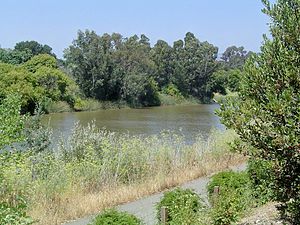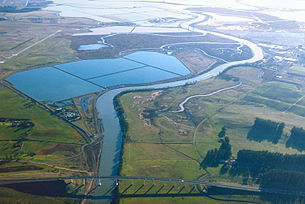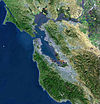- Napa River
-
Napa River River Country United States State California Regions Napa County, Solano County Tributaries - left Conn Creek, Rector Creek, Soda Creek, Milliken Creek - right Dry Creek City Napa Source Mount Saint Helena - location Mayacamas Mountains [1] - elevation 3,745 ft (1,141 m) [2] - coordinates 38°39′52″N 122°37′14″W / 38.66444°N 122.62056°W [1] Mouth Carquinez Strait - location San Pablo Bay - elevation 0 ft (0 m) - coordinates 38°4′12″N 122°14′38″W / 38.07°N 122.24389°W [1] Length 55 mi (89 km) [3] Basin 426 sq mi (1,103 km2) [4] Discharge [5] - average 210 cu ft/s (5.9 m3/s) - max 26,200 cu ft/s (741.9 m3/s) - min 0 cu ft/s (0 m3/s) The Napa River, approximately 55 miles (89 km) long, is a river in the U.S. state of California. It drains a famous wine-growing region, called the Napa Valley, in the mountains northeast of San Francisco. Milliken Creek is a tributary of the Napa River.
Contents
Course
The Napa River rises in northwestern Napa County just south of the summit of Mt. St. Helena in the Mayacamas Mountains of the California Coast Ranges. The source begins as seasonal Kimball Canyon Creek in Robert Louis Stevenson State Park at an elevation of 3,745 feet (1,141 m) which descends the southern slope of Mt. St. Helena to Kimball Canyon Dam.[1] [6] It flows south for 4 miles (6 km), entering the head of the slender Napa Valley north of Calistoga. In the valley, it flows southeast past Calistoga, St Helena, Rutherford, Oakville and through Napa, its head of navigation. Downstream from Napa, it forms a tidal estuary, entering Mare Island Strait, a narrow channel on the north end of San Pablo Bay. Where the Napa River discharges into San Pablo Bay is a large wetland known as the Napa Sonoma Marsh.
Ecology
Known for the vineyards in its valley, the river also supports a remarkable diversity of fishes and recovering salmonid populations, especially Chinook salmon (Oncorhyncus tshawytscha) and Steelhead trout (Oncorhyncus mykiss). In 2003 the Napa County Resource Conservation District began an ongoing salmon monitoring program, and have recorded a run of approximately 400 - 1000 fall-run Chinook salmon the past several years.[7] The Chinook run begins in late October through January. Conclusive evidence of historical Chinook salmon populations in the Napa River basin have not been established, but the river provides appropriate habitat for salmon and its location near the entrance to the Sacramento/San Joaquin Rivers make it likely that salmon would have at least ventured into the Napa River.[8][9] The Napa River basin is estimated to have historically supported a spawning run of 6,000–8,000 steelhead, and as many as 2,000–4,000 Coho salmon (Oncorhyncus kisutch).[9][10] By the late 1960s, coho salmon were extirpated from the watershed and the steelhead population is now reduced to less than a few hundred adults. Flow reductions in key rearing streams have reduced food availability for juvenile steelhead, causing reduced growth and survival.[9] Recently, a Chum salmon (Oncorhynchus keta) was caught in the river.[11]
Although diminished, the Napa River basin continues to support a fish community of greater diversity than even the Sacramento and San Joaquin River systems, including a nearly intact community of sixteen native fish species, including Steelhead, fall-run Chinook salmon, Pacific (Lampetra tridentata) and River lamprey (Lampetra ayresi), Hardhead (Mylopharodon conocephalus), Hitch (Lavinia exilicauda), Tule perch (Hysterocarpus traski), and Sacramento splittail (Pogonichthys macrolepidotus).[12] Because of this diversity the Napa River has been prioritized for special protection.[9] White sturgeon (Acipenser transmontanus) and many other native and non-native fishes currently utilize the Napa River watershed.[11]
The California Golden Beaver (Castor canadensis subauraticus) was historically extant.[13][14] Recently beaver have recolonized the Napa River.[15]
Watershed
The Napa River watershed encompasses approximately 426 square miles (1,103 km²). Larger tributaries, such as Dry, Conn, and Soda creeks, show signs of recent incision and have graded to the incised current level of the mainstem Napa River. In some cases, smaller tributaries cutting across the valley floor have not fully adjusted to the lowered level of the mainstem and are elevated at their confluence with the mainstem, forming potential barriers to upstream fish migration. Several large dams were built between 1924 and 1959 on major eastside tributaries (Conn, Rector, Milliken, and Bell dams) and the northern headwaters of the Napa River (Kimball Dam). In addition, many smaller dams can be found throughout the watershed.[9] These numerous dams are impassable barriers to salmon and steelhead seeking their historic spawning grounds.
Restoration in 1970s
As part of urban renewal in the 1970s, a concrete cover was removed from culverted sections of the Napa Creek, re-exposing the water to daylight. There is some debate as to whether this constituted one of the country's earliest "daylighting" projects, since the construction was undertaken with little thought to the river's ecology or restoration of riparian habitat.[16] [17] Napa Creek is a western tributary of the Napa River in downtown Napa. This construction is not believed to be responsible for later flooding along the river.
Current Restoration
Vineyard owners with property that borders the Rutherford Reach, a 4.5-mile (7.2 km) stretch of the Napa River between St. Helena and Oakville, are allowing prime land to return to a natural state in order to help preserve the ecology of the river. The project known as Rutherford Restoration Project involves 23 property owners have combined forces to provide 18 acres (73,000 m2) of land to this cause. [18] The southern part of the river has also been undergoing restoration as former salt ponds along the river are being restored to their natural state.[19]
Napa Flood of 1986
Main article: Napa River flood of 1986In 1986, the worst of 23 floods recorded since 1865 on the Napa River occurred, and 5,000 people were evacuated, 250 homes were destroyed, and three people died.
Napa River-Napa Creek Flood Protection Project
After the devastating flood of 1986, the dormant Napa River Flood Project was revitalized. The Project underwent a lengthy redesign and was approved by the local voters in 1998. Construction began in 2000 and is projected to be completed by 2015.
Recreation
The Napa River and the surrounding watershed provide many recreational opportunities. Whitewater kayaking and rafting can be done on the upper section of river from St. Helena to Napa. The lower section of the Napa River from Napa to San Pablo Bay has flatwater that is suitable for canoeing, sea kayaking and motorboating. The Napa River Trail has segments at Kennedy Park (N 38.26764 W 122.28373) & between Lincoln Ave (N 38.31055 W 122.27783) and Trancas St (N 38.32496 W 122.28384) in the city of Napa.
Film shot on the Napa River
- 1976-1977: Apocalypse Now (Apocalypse Now) directed by Francis Ford Coppola
References
- ^ a b c d U.S. Geological Survey Geographic Names Information System: Napa River
- ^ Google Earth elevation for source coordinates
- ^ About Napa River, Developing A Nutrient Management Plan for Napa River Watershed
- ^ Napa River Watershed, Napa County Resource Conservation District
- ^ Water Resources Data—California, Water Year 2004, Volume 2
- ^ Courtney, Kevin (March 3, 2009). "A search for Napa River's start runs through the heart of the valley". Napa Valley Register (Napa, CA: Lee Enterprises, Inc.). http://napavalleyregister.com/news/local/article_9b4beba8-3a28-11df-83ca-001cc4c002e0.html. Retrieved August 29, 2010.
- ^ Jonathan Koehler, Chad Edwards (August, 2008). Napa River Salmon Monitoring Program Spawning Year 2007 Report (Report). Napa County Resource Conservation District. http://www.napawatersheds.org/files/managed/Document/3572/Napa%20River%20Salmon%20Report%202008.pdf. Retrieved 2010-07-10.
- ^ Leidy, R.A., G.S. Becker, B.N. Harvey (2005). Historical distribution and current status of steelhead/rainbow trout (Oncorhynchus mykiss) in streams of the San Francisco Estuary, California (Report). Oakland, CA: Center for Ecosystem Management and Restoration. http://www.cemar.org/pdf/solano.pdf. Retrieved 2010-07-10.
- ^ a b c d e Napa River Basin Limiting Factors Analysis (Report). Stillwater Sciences. 2002. http://www.waterboards.ca.gov/sanfranciscobay/water_issues/programs/TMDLs/napasediment/lfa_executive_summary.pdf. Retrieved 2010-07-10.
- ^ Treleven, Mike (August 16, 20010). "More fish seem to be living in Napa River". Napa Valley Register (Napa, CA: Lee Enterprises, Inc.). http://napavalleyregister.com/news/local/article_37bd36c4-a8ef-11df-b43f-001cc4c03286.html. Retrieved August 29, 2010.
- ^ a b Jonathan Koehler (2008). Fishes of the Napa River Watershed (Report). Napa County Resources Conservation District. http://www.naparcd.org/documents/FishesoftheNapaRiverWatershed-Koehler2008.pdf. Retrieved 2010-07-11.
- ^ Robert A. Leidy (1999). Robert A. Leidy Fish Survey 1992-1998 Bay Area Stream Fishes (Report). San Francisco Estuary Institute. http://legacy.sfei.org/ecoatlas/Animals/docs/Fish/images/basf_v12.pdf. Retrieved 2010-07-11.
- ^ John E. Skinner, ed (1962). The Mammalian Resources in An Historical Review of the Fish and Wildlife Resources of the San Francisco Bay Area. http://www.estuaryarchive.org/archive/skinner_1962/9/. Retrieved Jan. 10, 2020.
- ^ William Alexander Trubody and Charles L. Camp (June, 1937)). "William Alexander Trubody and the Overland Pioneers of 1847". California Historical Society Quarterly, Vol. 16, No. 2: 134. JSTOR 25160711.
- ^ T. C. Dewberry. Development and Application of Anchor Habitat Approaches to Salmon Conservation: A synthesis of data and observations from the Napa watershed, California (Report). Friends of Napa River. http://www.icarenapa.org/docs/steelheadfinal.pdf. Retrieved 2010-07-10.
- ^ "Bay Area Cities Rediscover the Creeks Under Their Streets". Streetsblog. http://sf.streetsblog.org/2010/04/09/bay-area-cities-redscover-the-creeks-under-their-streets/.
- ^ Courtney, Kevin (August 29, 2010). "Early settlers found a Shangri-La, then they drained and boxed it". Napa Valley Register (Napa, CA: Lee Enterprises, Inc.). http://napavalleyregister.com/news/local/2c5deb90-b32e-11df-8658-001cc4c03286.html. Retrieved August 29, 2010.
- ^ Courtney, Kevin (September 6, 2010). "Vintners sacrifice vines to create a more natural Napa River". Napa Valley Register (Napa, CA: Lee Enterprises, Inc.). http://napavalleyregister.com/news/local/article_3044b422-b96f-11df-9ba4-001cc4c002e0.html. Retrieved September 6, 2010.
- ^ Courtney, Kevin (September 5, 2010). "Given up for dead, lost wetlands springing back to life in south county". Napa Valley Register (Napa, CA: Lee Enterprises, Inc.). http://napavalleyregister.com/news/local/article_4dcf4dea-b96f-11df-8d66-001cc4c002e0.html. Retrieved September 6, 2010.
External links
- Napa River Watershed
- UCSB: Napa Watershed
- Napa River Flood Project
- Napa River Trail Downtown Napa
- Photo documentary of the Napa River from SamandaDorger.com
See also
- List of rivers in California
- List of watercourses in the San Francisco Bay Area
Categories:- Rivers of Napa County, California
- Rivers of Solano County, California
- San Francisco Bay
Wikimedia Foundation. 2010.



